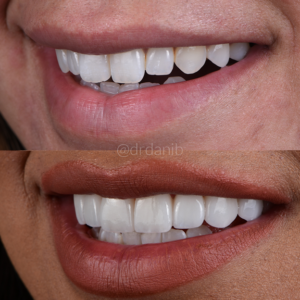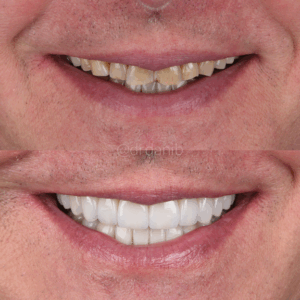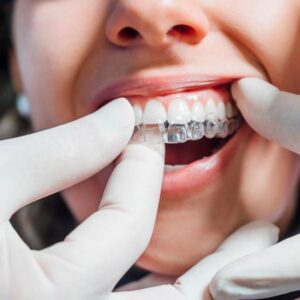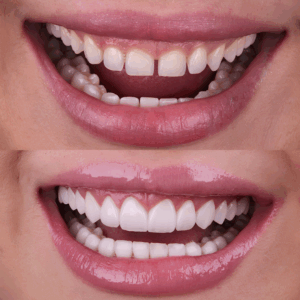Imagine this: You’ve had a dental crown placed to restore a damaged tooth. It looks great, feels strong, and functions perfectly. You might assume this restored tooth is now “immune” to decay. Unfortunately, that common assumption is a misconception.
While a dental crown is one of the most effective ways to protect and strengthen a damaged tooth, the natural tooth structure underneath remains biologically vulnerable to bacteria and decay.
What a Dental Crown Actually Does
A dental crown is a custom-made cap that your dentist permanently cements over a prepared natural tooth. It’s designed to restore the tooth’s original shape, size, strength, and appearance.
Crowns are essential for protecting teeth that have been structurally compromised by deep decay, large or failing fillings, severe fractures, or after root canal therapy. They distribute biting force evenly, preventing the weakened tooth from fracturing.
Common crown materials include strong, aesthetic options like porcelain, ceramic, zirconia, or a combination of materials. A crown protects the visible part of the tooth, the area above the gumline. The tooth’s root structure and the base of the natural tooth beneath the crown remain intact. Because this natural structure remains, it is still a biological surface susceptible to the same bacteria and plaque that cause cavities on any other tooth.
Can Dental Crowns Decay? The Short Answer: Not Exactly, but the Tooth Can
The answer to whether crowns can decay is a definitive no. Crowns are made of inert materials, such as ceramics or metals,that are not susceptible to bacterial acid erosion like natural enamel is. You will never get a cavity in the porcelain or zirconia itself.
However, the problem lies at the intersection of the crown and the tooth.
Decay occurs in the natural tooth structure beneath the crown or, more commonly, around its edges, known as the crown margin. This margin is the seam where the crown meets your natural tooth structure, often right at the gumline.
When bacteria and plaque collect at this margin, they begin to dissolve the natural tooth material. Over time, this erosion can create microscopic gaps in the dental cement. This allows the decay-causing bacteria to sneak beneath the protective edge of the crown, where they can then silently attack the vulnerable tooth structure underneath.
The Most Common Causes of Decay Under Crowns
Decay under a crown is not random; it’s usually the result of a specific breakdown in the seal or a lack of meticulous hygiene.
Poor Oral Hygiene
This is the single biggest factor. Inadequate brushing and flossing, especially right along the crown margin at the gumline, allows a persistent film of plaque to build up, which is the direct cause of decay.
Leaky Margins or Aging Dental Cement
Dental cement isn’t permanent. Over many years, it can naturally erode, dissolve, or loosen. When the seal is compromised, even a tiny gap creates a highway for bacteria to travel underneath the crown.
Gum Recession
As gums naturally recede with age, or due to aggressive brushing habits, more of the tooth root beneath the crown margin can become exposed. Root surfaces are softer and far more vulnerable to decay than enamel, making them a high-risk area.
Diet and Lifestyle
A frequent intake of sugary snacks, sodas, or highly acidic foods creates an environment in the mouth that encourages bacterial growth and accelerates the breakdown of the crown-to-tooth seal.
Existing Decay Before Crown Placement
In rare cases, if residual decay or bacteria was inadvertently left behind before the crown was permanently cemented, it can continue to progress underneath, even beneath a perfectly fitted restoration. This is why meticulous preparation is essential.
How to Recognize Decay Under a Crown
Decay beneath a crown often develops silently for months or even years because the crown masks the visual symptoms. You must be vigilant and listen to your body.
Warning signs that indicate a potential problem may include:
- Tooth Sensitivity: A sudden or increasing sensitivity, especially to heat, cold, or sweetness.
- Pain or Discomfort: Pain when biting or chewing, or a dull, persistent ache in the crowned area.
- Dark Lines or Discoloration: You might notice a dark or brown line appearing right along the gumline edge of the crown.
- Swollen or Bleeding Gums: Inflammation or bleeding when you brush around the crown.
- A Loose Crown: In advanced stages, the decay can destroy enough of the tooth structure that the crown feels loose or wobbly.
- Bad Taste or Bad Breath: A lingering bad taste or odor that won’t go away could indicate an infection.
Tip: Regular dental checkups often catch crown-related decay at a very early stage, long before you start experiencing these painful or obvious symptoms.
Diagnosing Decay Beneath a Crown
Because a crown is opaque, traditional visual examination can be ineffective at detecting decay underneath. This is where modern diagnostic tools become indispensable.
Dentists rely on digital X-rays to look beneath the crown. Decay appears as dark shadowing or a radiolucent area around the margin or beneath the material. For complex cases, CBCT imaging (Cone-Beam Computed Tomography) or other 3D scans can provide a more detailed view to detect hidden, three-dimensional decay patterns.
Early diagnosis is the key to minimal treatment. Detecting decay when it’s small often allows for a simple fix, preventing the damage from spreading deeper into the tooth’s core.
Treatment Options for Decayed Teeth Under Crowns
The treatment for decay under a crown depends entirely on how extensive the damage is:
- Small Areas of Decay: If the decay is minimal and localized at the margin, it may sometimes be cleaned and sealed. In rare cases, the existing crown may be preserved if the decay is easily accessible.
- Moderate Decay: Most often, the crown will need to be carefully removed, the decay thoroughly cleaned out and filled, and a new crown fabricated and placed. Reusing an old crown after a significant amount of decay removal is often impossible due to structural changes.
- Severe Decay or Infection: If the decay has reached the tooth’s nerve or pulp, root canal therapy will be required to save the tooth before a new, permanent crown can be placed. In extreme cases, where the remaining tooth structure is too compromised, extraction and replacement with a dental implant may be the only viable option.
How to Prevent Decay Under Crowns
Maintain Strong Daily Oral Hygiene
- Brush twice daily using a soft-bristle toothbrush and a fluoride toothpaste. Pay special attention to the gumline where the crown meets your natural tooth.
- Floss carefully around the crown margins once a day. If you struggle with traditional string floss, consider using a floss threader or a water flosser (which is excellent for cleaning under crowns and bridges) to ensure the margins are spotless.
Schedule Regular Dental Checkups and Cleanings
- This is non-negotiable. Professional exams every six months allow your dental team to detect small issues, like a weakening margin, before they become major problems.
- Hygienists are experts at removing hardened plaque (tartar) that normal brushing cannot reach, especially around the crown-gum interface.
Watch Your Diet
- Limit sugary snacks, sodas, and highly acidic foods that wear down enamel and encourage bacterial growth.
- Rinse your mouth with water or chew sugar-free gum after consuming sweet or sticky foods to neutralize acids.
Protect Your Crowns from Damage
- Avoid chewing on ice, popcorn kernels, or hard candies to prevent chips, cracks, or loosening the crown.
- If you grind or clench your teeth (bruxism), wear a custom-fitted nightguard provided by your dentist to protect your crowns and natural teeth from excessive force.
Replace Aging Crowns on Time
Most crowns are built to last 10–15 years, but they are not indefinite. Wear, cement degradation, or changes in your gum health may necessitate replacement earlier. Your dentist will monitor your crowns and advise you on the best time for a restoration.
The Role of Advanced Dental Technology in Prevention
We prioritize advanced diagnostics to protect and preserve your investment in your crowned teeth. We don’t just treat problems; we detect and prevent them.
- Intraoral Cameras: These allow us to show you a magnified, high-definition image of your crown margins, helping you understand and visualize exactly what we see.
- Digital X-rays and CBCT Scans: These tools provide a clear, low-radiation image that is essential for detecting hidden decay lurking beneath a crown or a filling.
- Laser Cavity Detection: High-tech devices can identify weak spots in the natural tooth structure, often long before decay has penetrated the surface, allowing for early, non-invasive intervention.
What Happens If Decay Is Left Untreated
Ignoring the early signs of decay beneath a crown is a recipe for serious and expensive complications. Untreated decay can spread quickly, leading to:
- A severe tooth infection or abscess at the root tip.
- Total crown failure or breakage due to lack of underlying support.
- Intense pain and swelling requiring emergency treatment.
- Potential tooth loss if the remaining natural structure becomes too compromised to support any restoration.
Early detection prevents invasive procedures and the costly process of emergency crown removal and tooth rescue.
Long-Term Protection: Crown Care Tips for Every Patient
Commit to these simple habits to maximize the lifespan of your crowns and the health of the teeth they cover:
- Use an alcohol-free fluoride rinse daily to strengthen exposed enamel and root surfaces.
- Maintain a balanced diet rich in calcium and Vitamin D to support strong, healthy bone and enamel.
- Be consistent with your six-month dental visits, do not skip them!
- Ask your dentist about sealants or varnishes that can be applied to vulnerable, exposed root surfaces to provide an extra layer of protection.
- Address gum issues early, healthy, tight gums are your first line of defense, as they protect the critical crown margins.
Why Choose Dr. Dani B. for Crown Maintenance and Restoration
We understand that a dental crown is a long-term investment in your health and confidence. Our commitment is to precision dentistry and prevention.
Dr. Dani B. and the team combine years of experience in restorative dentistry with the most modern diagnostic tools available to provide gentle, comprehensive care. We excel at restoring old or failing crowns, ensuring a perfect seal, and educating patients on how to prevent future issues.
We treat every crown not just as a restoration, but as an essential part of a healthy, confident, and beautiful smile that is designed to last.
Conclusion: Protect the Tooth Beneath the Crown
The core takeaway is simple: Crowns protect, but they do not make your teeth invincible. The natural tooth underneath is still a biological structure that requires daily care.
With consistent, meticulous home hygiene, regular professional checkups, and a trusted dental team utilizing advanced diagnostic technology, you can successfully preserve both the crown and the natural tooth beneath it.
If you’ve noticed sensitivity, discomfort, dark edges, or any unusual symptoms around your crown, schedule an evaluation with Dr. Dani B. We will ensure your smile stays strong, healthy, and beautiful for years to come.








